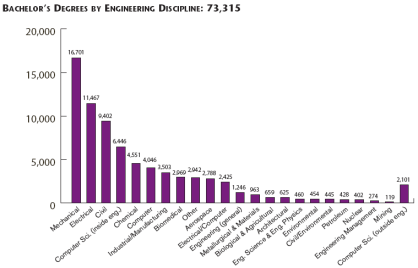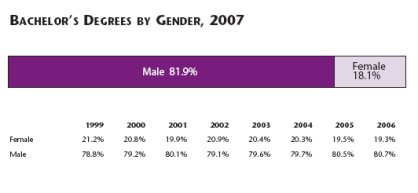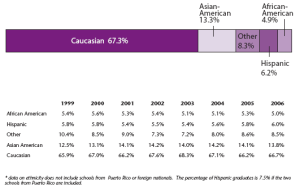ENGINEERING EDUCATION / GRADUATION RATES FOR 2006/2007
June 23, 2009
The number of students graduating from four-year accredited colleges and universities is painfully small compared to our national needs. There are more retirements, deaths, changes of occupations, etc. from the engineering ranks than people entering the field. If we are to maintain our technological edge, we will need more engineering manpower.
Let’s take a look at the graduation rates for engineering students for the academic years 2006 through 2007. These numbers are furnished by Mr. Michael T. Gibbons in his paper “Engineering by the Numbers” and represent statistical information for all engineering schools, both public and private, in the United States. These are not “global” numbers; just an accounting for the USA during that time period. As you can see, the total number of four year graduates is quite small compared to the college of liberal arts, business, accounting, marketing, etc etc. The numbers simply reflect the fact that, on a yearly basis, fewer and fewer individuals are graduating from the various engineering disciplines. As a matter of fact, bachelor degrees awarded in engineering declined for the first time since the 1990s; ending seven years of growth.

Engineering Graduation Rates for 2006-2007
If we look at male vs. female, we find that the male graduates far outnumber female graduates. Overwhelmingly, American women simply do not choose engineering as a viable profession. I feel this is due to several factors, as follows:
- “You will never catch a man if you act too smart”. So the daughter acts really dumb and she catches a really dumb guy. Mothers (and grandmothers) are very aware of the “social stigma” some girls develop as a result of being considered a “nerd”. Even young ladies who have an interest in engineering are affected by parents and peer pressure to pursue other avenues of interest. A real tragedy.
- Engineering is still considered a hands-on profession and many young ladies, as well as men, do not wish to get their hands dirty, even when most engineering jobs today do not require that approach.
- The pay scale for graduate engineers is still very low compared to some less rigorous white collar occupations. The notion of “being rich” or even “super-rich” is very appealing and people will work in a profession they don’t enjoy just to get a shot at “stardom”.
- The engineering profession is one in which life-long learning is an absolute must if one is to remain viable and productive. You don’t burn your books when you complete your formal studies.
- Sad but true, the engineering rigor leaves little time for beer drinking and “Miller Time”. There are many Friday and Saturday nights spent behind a book instead of in front of a bar. As my old football coach told us, ‘you gota want it’.
Take a look at the statistics below. The numbers do remain fairly steady with a slight drop for female students in 2005 and 2006.

Degrees by Gender
If we look at the data by ethnicity, we find the greatest number of students to be from the Caucasian side of the human equation. We won’t examine Master Degree and Doctoral statistics here but the percentage of Asian students increases with advanced degrees.

Ethnicity
This fact mirrors the imbalance in our educational system relative to opportunity given or taken by the African-American and Hispanic community. Engineering is still an all-male, all-white game only a few are willing to play.
I was very surprised to find that the number of foreign nationals is significantly lower than I remembered it being. There is one reason for this; 9-11. The terrorist attack on the World Trade Towers, September 11th, created a situation in which students applying to our schools, hoping to enter as freshmen, has taken a significant hit. Please look at the chart below to see what I mean.

Degrees by Residency
As you can see, the largest enrollments are by far “domestic”, students coming from within the United States. Only 6.7% are foreign nationals. Several years ago I was asked by the Dean of the College of Engineering at the University of Tennessee, Chattanooga, to teach a seminar of graduating seniors. The session was entitled “The Real World”. It was a discussion on the every-day life of a blue-collar, working engineer. I was very happy to do so, thinking my forty years in manufacturing might indicate that it really is a fascinating profession and one you can remain in without sacrificing too much. I did notice that approximately half the class was foreign. Even smaller, the number of female students! This was prior to 9-11.
The last chart will show the enrollment for 2006/2007. The dropout rate during a four or five year period is significant and points out the fact that it’s a tough course of study and some students are simply not prepared for the rigor. The graduation rate for engineering students is approximately 20%. For students in liberal arts, business, economics, finance, marketing, sales, etc. the rate approximates 55%. Sill not stellar numbers but better than engineering. I honestly believe most drop out due to fatigue. I have been told by several engineering professors that more and more students must attend remedial classes for math, English, and even some students take classes in college not having completed their course work in high school. Things have certainly changed since I was a freshman.
The next graph will show the undergraduate enrollment by discipline for all engineering categories. One mention, ladies who do enter engineering, are enrolling in fields of study such as biomedical, environmental , landscape engineering and there is a significant move towards biomedical engineering; then, the graduate enters medical school. This is found to be an excellent course of study for the medical profession.

Undergraduate Enrollments by Discipline
There are studies that indicate the engineering graduation rates for China and India are 400,000 to 500,000 per year. We need to be very careful and make sure the definition of an engineer in this country relative to “overseas” are the same. We are discussing a four year, accredited engineering school and not a two year technical college or an on-line certificate program. The latter programs may have their place in society, and do, but a four year course of study provides capabilities that can not be found with any other type of institution. Some authorities feel the graduation rates of China and India are inflated and both countries count two-year colleges in the data. Even if that’s true, the differences in enrollments are staggering.
If we are to keep our technological edge in this country, we must entice, educate and pay an ever-increasing number of individuals to enter the field of engineering and then keep them occupied and employed with meaningful full-time work. Engineering is a fascinating field of study and one greatly needed in our world today. Also, the discipline imparted during the educational process is extremely valuable and can be used regardless of the profession applied. In other words, engineering prepares an individual for a variety of fields and gives them the necessary background for life-long learn
BOOK REVIEW OF “10-10-10”
June 9, 2009
I recently completed reading a fascinating book entitled “10-10-10” by Suzy Welch. The publisher is Scribner, with a copyright of 2009. It attracted my attention because, until my retirement, I was an employee of General Electric. Suzy Welch is the wife, I should say current wife, of Jack Welch. ( Jack moves around !!!!! ) At any rate—good book and one in which I can certainly recommend. The basic theme details a decision-making process in which the consequences of decision-making are considered in ten minutes, ten months and ten years. There is definitely a cause/effect relationship with all decisions so short-term and long-term effects may or may not be painful depending upon your core values and stated goals.
The first step in every 10-10-10 process starts with a statement of the dilemma or decision to be made. The author recommends writing it down and making it as detailed as possible. Next comes data collection. Find out as much supporting information as possible relative to a potential solution. Third and last, analysis. Take the information you have and compare that with your goals, values, dreams, desires, etc. Then, with the possible solution(s), apply the 10-10-10 methodology. What will be the consequences in ten minutes, ten month and ten years. This approach is basically applying the scientific process that William of Ockham postulated with his statement “all things being equal, the best solution is the simplest solution”. The methods don’t vary that much.
Mrs. Welch asks several very interesting questions relative to values, such as:
1.) What would make you cry at your seventieth birthday?
2.) What do I want people to say about me when I’m not in the room”
3.) What do you love about the way your parents live and what do you hate?
The book is replete with examples of decisions made by “real people” and how they applied the process to bring about satisfactory decision making. The areas of the book address career, raising kids, conduct in the work-place, friendships, leaving one job for another. She is “heavy” on working relationship and when to leave them. This is exemplified by asking and answering the following questions:
1.) Does my job allow me to work with my people—those who share my sensibilities about life or do I have to zone out, fake it, or put on a persona to get through the day?
2.) Does my job make me smarter by stretching my mind, building my skills and taking me out of my comfort zone?
3.) Does my job open doors for me?
4.) Does my job give me meaning?
All good questions and ones in which we all should ask ourselves some time in our working life.
You can definitely tell it was written by a lady by the approach she takes and the examples used. There are sensitivities there that a “guy”would not really consider. The last question in the book occurs at a dinner party in which the host asks all the guests to name six couples who are truly happy. It’ a “good read” and a book that I would definitely recommend.
CIELO TECHNOLOGIES, LLC
June 5, 2009

Carpe Diem
This is the “logotype” of Cielo Technologies, LLC. We are a consulting engineering firm specializing in automating manufacturing processes, designing components and subassemblies for commercial products and technical writing for industry. Our company has published five (5) technical papers on the following subjects:
1. Fundamentals of Gas Combustion
2.) Reliability Engineering and Reliability Testing
3.) Adhesives Technology
4. Light-Cure Adhesives
5. Engineering Program Management (E-PMSRA)
All publications have been through PDHonline for professional engineers required to have 12 PDH hours per year. This is an ongoing requirement for professional engineers active in approximately 40 states, the US Virgin Islands, Guam and Puerto Rico.
Please visit our web site at http://www.cielotech.us.
Many thanks,
Bob Jackson, PE


